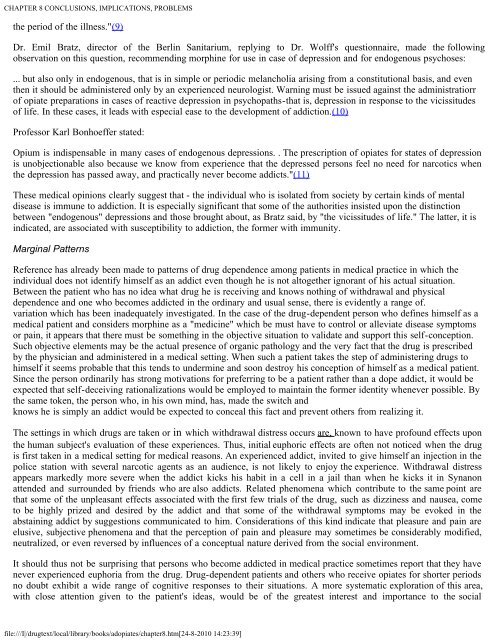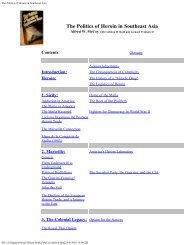Addiction and Opiates
Addiction and Opiates
Addiction and Opiates
You also want an ePaper? Increase the reach of your titles
YUMPU automatically turns print PDFs into web optimized ePapers that Google loves.
CHAPTER 8 CONCLUSIONS, IMPLICATIONS, PROBLEMS<br />
the period of the illness."(9)<br />
Dr. Emil Bratz, director of the Berlin Sanitarium, replying to Dr. Wolff's questionnaire, made the following<br />
observation on this question, recommending morphine for use in case of depression <strong>and</strong> for endogenous psychoses:<br />
... but also only in endogenous, that is in simple or periodic melancholia arising from a constitutional basis, <strong>and</strong> even<br />
then it should be administered only by an experienced neurologist. Warning must be issued against the administratiorr<br />
of opiate preparations in cases of reactive depression in psychopaths-that is, depression in response to the vicissitudes<br />
of life. In these cases, it leads with especial ease to the development of addiction.(10)<br />
Professor Karl Bonhoeffer stated:<br />
Opium is indispensable in many cases of endogenous depressions. . The prescription of opiates for states of depression<br />
is unobjectionable also because we know from experience that the depressed persons feel no need for narcotics when<br />
the depression has passed away, <strong>and</strong> practically never become addicts."(11)<br />
These medical opinions clearly suggest that - the individual who is isolated from society by certain kinds of mental<br />
disease is immune to addiction. It is especially significant that some of the authorities insisted upon the distinction<br />
between "endogenous" depressions <strong>and</strong> those brought about, as Bratz said, by "the vicissitudes of life." The latter, it is<br />
indicated, are associated with susceptibility to addiction, the former with immunity.<br />
Marginal Patterns<br />
Reference has already been made to patterns of drug dependence among patients in medical practice in which the<br />
individual does not identify himself as an addict even though he is not altogether ignorant of his actual situation.<br />
Between the patient who has no idea what drug he is receiving <strong>and</strong> knows nothing of withdrawal <strong>and</strong> physical<br />
dependence <strong>and</strong> one who becomes addicted in the ordinary <strong>and</strong> usual sense, there is evidently a range of.<br />
variation which has been inadequately investigated. In the case of the drug-dependent person who defines himself as a<br />
medical patient <strong>and</strong> considers morphine as a "medicine" which be must have to control or alleviate disease symptoms<br />
or pain, it appears that there must be something in the objective situation to validate <strong>and</strong> support this self-conception.<br />
Such objective elements may be the actual presence of organic pathology <strong>and</strong> the very fact that the drug is prescribed<br />
by the physician <strong>and</strong> administered in a medical setting. When such a patient takes the step of administering drugs to<br />
himself it seems probable that this tends to undermine <strong>and</strong> soon destroy his conception of himself as a medical patient.<br />
Since the person ordinarily has strong motivations for preferring to be a patient rather than a dope addict, it would be<br />
expected that self-deceiving rationalizations would be employed to maintain the former identity whenever possible. By<br />
the same token, the person who, in his own mind, has, made the switch <strong>and</strong><br />
knows he is simply an addict would be expected to conceal this fact <strong>and</strong> prevent others from realizing it.<br />
The settings in which drugs are taken or in which withdrawal distress occurs are, known to have profound effects upon<br />
the human subject's evaluation of these experiences. Thus, initial euphoric effects are often not noticed when the drug<br />
is first taken in a medical setting for medical reasons. An experienced addict, invited to give himself an injection in the<br />
police station with several narcotic agents as an audience, is not likely to enjoy the experience. Withdrawal distress<br />
appears markedly more severe when the addict kicks his habit in a cell in a jail than when he kicks it in Synanon<br />
attended <strong>and</strong> surrounded by friends who are also addicts. Related phenomena which contribute to the same point are<br />
that some of the unpleasant effects associated with the first few trials of the drug, such as dizziness <strong>and</strong> nausea, come<br />
to be highly prized <strong>and</strong> desired by the addict <strong>and</strong> that some of the withdrawal symptoms may be evoked in the<br />
abstaining addict by suggestions communicated to him. Considerations of this kind indicate that pleasure <strong>and</strong> pain are<br />
elusive, subjective phenomena <strong>and</strong> that the perception of pain <strong>and</strong> pleasure may sometimes be considerably modified,<br />
neutralized, or even reversed by influences of a conceptual nature derived from the social environment.<br />
It should thus not be surprising that persons who become addicted in medical practice sometimes report that they have<br />
never experienced euphoria from the drug. Drug-dependent patients <strong>and</strong> others who receive opiates for shorter periods<br />
no doubt exhibit a wide range of cognitive responses to their situations. A more systematic exploration of this area,<br />
with close attention given to the patient's ideas, would be of the greatest interest <strong>and</strong> importance to the social<br />
file:///I|/drugtext/local/library/books/adopiates/chapter8.htm[24-8-2010 14:23:39]





